My absolute favourite cast-on for circular shawls is the Invisible Loop cast-on. TechKnitter has an absolutely fabulous blog-post about how to work the cast-on. The reason I like this cast-on so much is that it’s relatively simple to do. And when you work the first few rounds of a circular shawl, it is not very tight, and allows you to wiggle the needles around. In the beginning it will look like you have a big hole in the centre of your shawl, but fear not – at the end when it’s time to sew in the ends, you pull the cast-on end and the hole disappears like this:
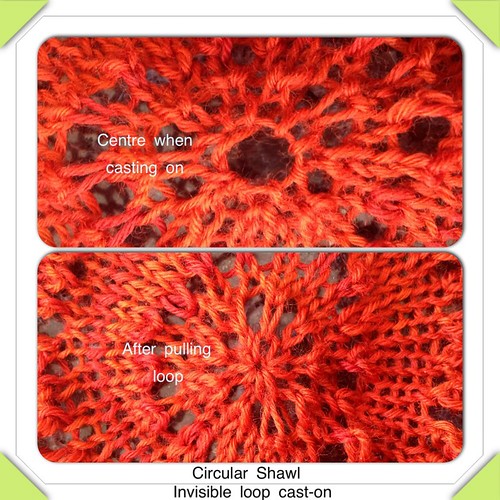
Afterwords, all you do is sew in the loose end. I like to loop it a few times through the centre stitches, and then duplicate-stitch the stitches around the centre, before I cut the yarn. It’s completely invisible and results in a neat centre that stands up to scrutiny.
Announcing the new Mystic KAL!
Mystic Supernova is a circular shawl inspired by the stellar explosions that are so bright they can outshine an entire galaxy.
There will also be a semicircular version of the shawl available (which uses approx. 1/2 the amount of yarn of the circular shawl).
MATERIALS
1 skein Wollmeise Lace-Garn
3.75 mm (US 5) needles
KAL START DATE: Apr 17, 2014
Clues posted every Thursday for 6 consecutive weeks.
The swatch will be posted on Apr 10, 2014.
SIGN UP TODAY
CDN $6.50 (KAL price will increase to regular pattern price upon the release of the first clue)
Come join us in the Knit & Knag Designs group on Ravelry for more KAL fun.
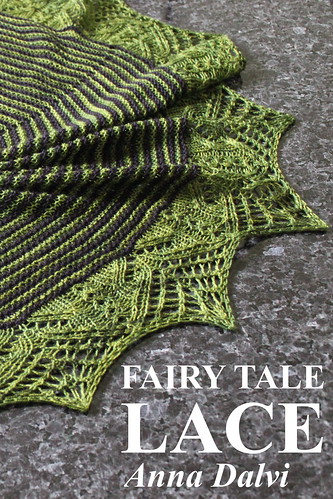
Fairy Tale Lace is a collection of 7 lace shawl patterns and the fairy tales that inspired the designs. I’ve been releasing the patterns one at a time since last summer, and the final pattern was just released last week.
I’ve always been fond of fairy tales. Throughout history, they have been used to amuse, teach, inspire, frighten and entertain all generations. It’s only in more recent times that fairy tales have been considered ‘stories for children’. Many of the traditional fairy tales contain elements targeted at an older audience, and these are really my favourite versions. There is usually a very clear division between the heroes of the story, which tend to be good, and the wicked, who tend to be not just a little naughty, but all out evil. And they always get their just desserts in the end. At least almost always.
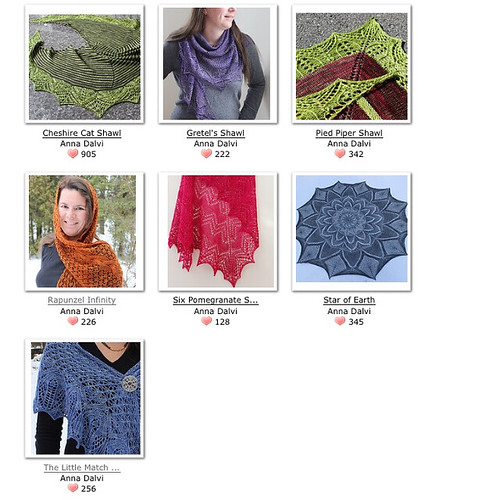 In this collection, several of the patterns are from stories collected by the Brothers Grimm. Most of us have probably heard these stories time and time again, both as children and then later as adults. We have the Pied Piper (or the Rat-catcher of Hameln), Hansel and Gretel and Rapunzel. The Cheshire Cat from Alice in Wonderland showed up with his stripes and ever-so-famous grin. There’s the sad Danish story by HC Andersen about the Little Match Girl who froze to death one cold New Years Eve. There is also a beautiful Chippewa tale called the Star of Earth, and a Greek myth about how Persephone was doomed to spend half of the year in the underworld with Hades.
In this collection, several of the patterns are from stories collected by the Brothers Grimm. Most of us have probably heard these stories time and time again, both as children and then later as adults. We have the Pied Piper (or the Rat-catcher of Hameln), Hansel and Gretel and Rapunzel. The Cheshire Cat from Alice in Wonderland showed up with his stripes and ever-so-famous grin. There’s the sad Danish story by HC Andersen about the Little Match Girl who froze to death one cold New Years Eve. There is also a beautiful Chippewa tale called the Star of Earth, and a Greek myth about how Persephone was doomed to spend half of the year in the underworld with Hades.
Hopefully you’ll enjoy these patterns as much as I have. I have a hunch that this is not the last Fairy Tale collection I create, so if you have a favourite fairy tale you’d like to see as a future pattern, let me know. I may just take requests. 
In the meantime, the Fairy Tale Lace collection is available as an e-book for CDN $20.

All of the patterns are also available as individual downloads on Ravelry, for various amounts depending on the complexity of the pattern.
Enjoy!!
Rapunzel Infinity is a completely reversible infinity scarf. It features lace and reversible cables, and is knit flat and grafted together at the end.
Rapunzel is a German fairy tale in which an enchantress has imprisoned a young girl in a tower. Rapunzel has long, golden hair, and she lowers her braid from the tower so that the enchantress can visit her. One day a prince pretends to be the enchantress, visits her and they fall in love. They plan her escape, but the enchantress finds out and casts out Rapunzel. She then pretends to be Rapunzel, and the prince climbs up to meet her. When she tells him he will never see Rapunzel again, he leaps from the tower in despair and is blinded by the thorns below.
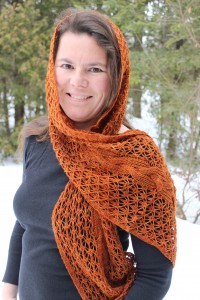 Rapunzel’s braid is shown in the centre of the infinity scarf, surrounded by thorns growing below the tower on both sides.
Rapunzel’s braid is shown in the centre of the infinity scarf, surrounded by thorns growing below the tower on both sides.
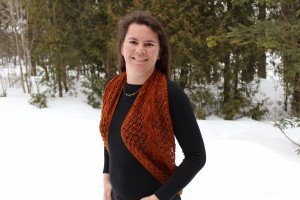 The fun thing with an infinity scarf is that there are so many different ways of wearing it. Short. Long. Wrapped around the head. As a vest.
The fun thing with an infinity scarf is that there are so many different ways of wearing it. Short. Long. Wrapped around the head. As a vest.
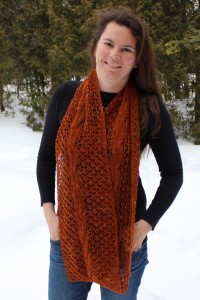 The Rapunzel Infinity pattern is available as a PDF download, both in single pattern form for CDN $5.00
The Rapunzel Infinity pattern is available as a PDF download, both in single pattern form for CDN $5.00
Or in the Fairy Tale Lace e-book, which includes a total of 7 patterns for CDN $20
Happy pi-day, everyone!
Here are four of my pi-shawls.
Clockwise from the top:
Mystic Star, Star of Earth, Ra and Apep, Eyjafjallajökull Shawl
A pi-shawl is a circular shawl using the so called pi-shawl construction, as described by Elizabeth Zimmerman. It relies on the relationship between the circumference of the shawl (the number of stitches) and the radius of the shawl (the number of rounds, counting out from the centre). Basically, each time the radius doubles, the circumference doubles. And since knit fabric is stretchy by nature, it’s sufficient to double the number of stitches every time the radius doubles. The stitches are increased in special increase rounds which are worked [k1, yo] to the end.
When knitting in the round, repeating a fairly simple pattern will result in a much more complex-looking pattern. These shawls use both lace patterning and “negative space” – that is the plain stockinette separating the lace patterns – to create the overall patterns.
I’ve been hard at work for the past few months preparing for the next book release. A couple of weeks ago I drove down to Boston to meet with Caro Sheridan for the photo shoot. We spent a day in the studio and she took lots of lovely pictures that will be in the book.
There were many shawls to photograph, and my jobs included keeping track of the shawls (to make sure they all got photographed), and styling them on the model.
Sometimes the styling was as simple as smoothing out the fabric.
And sometime the draping was more complicated, to make sure the lace patterning was showing as much as possible.
There was also some playing around, to capture the shawl in motion.
Now that we have the pictures, we’ve sorted through them to select the best ones. Caro is working on the colour-balancing and what not, and soon they will be delivered to the publisher so they can be included in the book.
Hansel and Gretel is a German fairy tale, from the Grimm fairy tales. Hansel and Gretel are children in a starving family. Their stepmother convince their father to abandon the children in the forest. The children overhear the plan, and gather pebbles that they use to mark their way home. At night, when the moon and the stars are up, they return home. The next day, they are once again brought into the woods. This time they mark their way home with breadcrumbs, but they are eaten by the birds, and the children are lost in the woods. They wander and find a gingerbread cottage belonging to a witch.
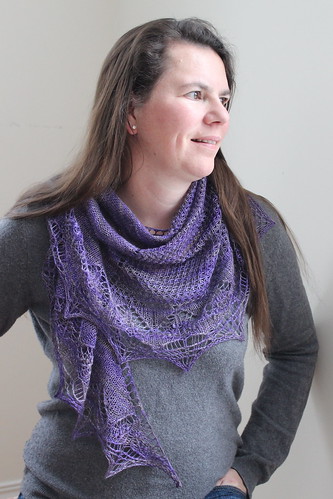
The body of the shawl is split into thirds. The centre shows the starlit night, surrounded by solid stockinette for the darker parts of the sky, and the edging represents the decorations on the gingerbread house.
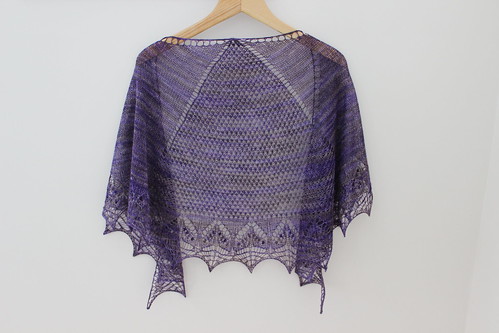
It’s knit using one skein of Handmaiden Marrakesh in amethyst, and on 3.75 mm needles. It’s available as part of the Fairy Tale Lace e-book, as well as in single pattern form.
The e-book is available for CDN $20

And if you’d just like a copy of Gretel’s Shawl, it’s available in PDF format for CDN $6.00

As everyone knows, red is the colour of love. I certainly have a special affinity for red. When I design, I really try to vary the colours I use, but red definitely keeps coming back. More often than not, really. I do love a good red.
One of my favourite reds is this red that I used for Mystic Roses:
 The yarn is from Wollmeise, and the colour is called Rosenrot – i.e. rose red. The colour was definitely a big part of the inspiration for this shawl.
The yarn is from Wollmeise, and the colour is called Rosenrot – i.e. rose red. The colour was definitely a big part of the inspiration for this shawl.
In the years since I knit Mystic Roses, I have worn it to numerous yarn festivals, teaching events and other yarny occasions, and it never fails to capture people’s attention. If I do say so myself, I am incredibly happy with how it turned out. It is still one of my favourite shawls, and I wear it often.
Happy Valentine’s Day, everyone!
During the last week of January, Kate Atherly and I were teaching on board the Celebrity Reflection during the Cooperative Press Knitting Cruise.
 It was a 7 day cruise leaving from Miami. There were a variety of classes available to the cruisers, ranging from Lace Design to Soxpertise, Sizing & Fit to Reversible Cables, and all sorts of other delightful topics. Linda Sokalski was also there teaching Swedish Twined Knitting and Modular knits.
It was a 7 day cruise leaving from Miami. There were a variety of classes available to the cruisers, ranging from Lace Design to Soxpertise, Sizing & Fit to Reversible Cables, and all sorts of other delightful topics. Linda Sokalski was also there teaching Swedish Twined Knitting and Modular knits.
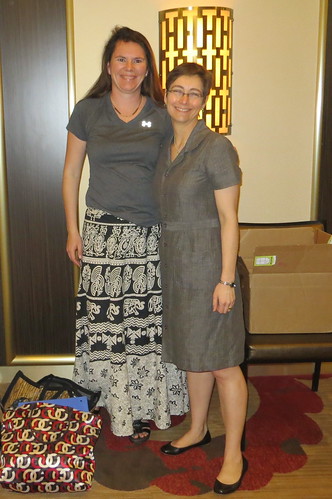
I have worked with Kate before – among other things she was the technical editor for Ancient Egypt in Lace and Color – but I had never had a chance to spend an entire week together with her. We had a lovely time. The classes were wonderful (many thanks to all our students for making this such a great experience for both of us) and in addition to that it was nice to just hang out and chat (and knit!) with another designer and author. We work so much via the internet and electronic communications, but sometimes it’s really great to have a real, live colleague in the same room at the same time.
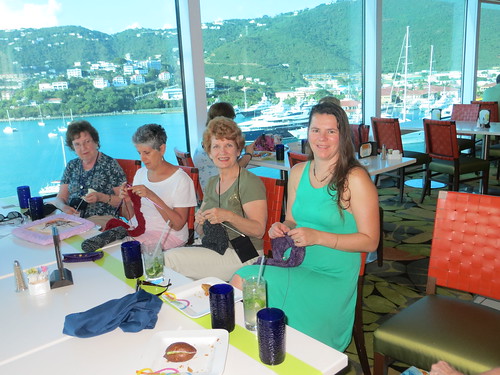 The classes were taught during the days that the ship was at sea. In addition, Linda (who is sitting right next to me in the picture above) arranged a couple of stitch-and-bitch sessions. At this one, the ship was getting ready to leave St. Thomas, and we got to enjoy both our knits, the company, and the fabulous view of the harbour as we were continuing on our journey to St. Maarten.
The classes were taught during the days that the ship was at sea. In addition, Linda (who is sitting right next to me in the picture above) arranged a couple of stitch-and-bitch sessions. At this one, the ship was getting ready to leave St. Thomas, and we got to enjoy both our knits, the company, and the fabulous view of the harbour as we were continuing on our journey to St. Maarten.
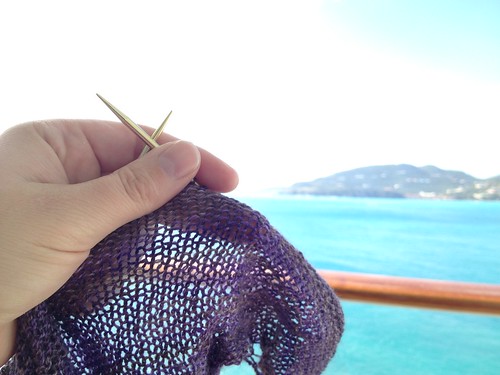 I also had the chance to get some knitting done on my next design on our own balcony. I’d grab a cup of tea and settle down and knit for a while. It was wonderful. And quite the stark contrast to the current weather at home (it was -25C in Ottawa during the week I was gone).
I also had the chance to get some knitting done on my next design on our own balcony. I’d grab a cup of tea and settle down and knit for a while. It was wonderful. And quite the stark contrast to the current weather at home (it was -25C in Ottawa during the week I was gone).
 And of course I had the chance to venture out on the islands while the ship was docked. It was absolutely heavenly to get to swim in the Caribbean in the middle of winter. I also went biking in Puerto Rico, and snorkling on St. Maarten. I miss the warmer weather during the summer when I can spend a lot more time outdoors at home. At this time of year, I tend to curl up by the fireplace instead. Also nice, but not quite the same.
And of course I had the chance to venture out on the islands while the ship was docked. It was absolutely heavenly to get to swim in the Caribbean in the middle of winter. I also went biking in Puerto Rico, and snorkling on St. Maarten. I miss the warmer weather during the summer when I can spend a lot more time outdoors at home. At this time of year, I tend to curl up by the fireplace instead. Also nice, but not quite the same.
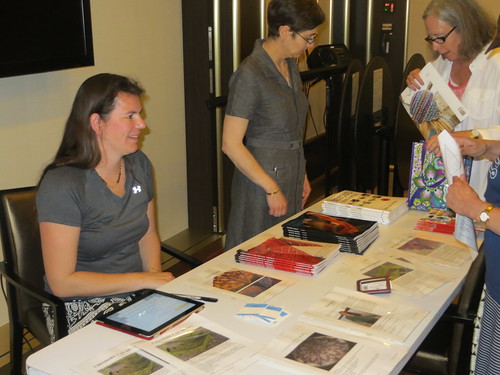 We also brought some books and patterns to sell. I had Shaping Shawls and Ancient Egypt in Lace and Color, as well as a number of single patterns, and Kate had brought her Beyond Knit & Purl, as well as Knit Accessories.
We also brought some books and patterns to sell. I had Shaping Shawls and Ancient Egypt in Lace and Color, as well as a number of single patterns, and Kate had brought her Beyond Knit & Purl, as well as Knit Accessories.
We met lots of lovely people, and I really want to thank everyone again for coming. And for those of you who didn’t get a chance to join us, I hope we do it again in the future. January is a most excellent time to take a break from winter by knitting in the Caribbean.
I met Gwen Bortner at TNNA a few years ago – we were both at the Yarn Thing Designer Dinner. She had recently published Entrée to Entrelac, and was kind enough to give me a copy. I haven’t knit a lot of entrelac, although I have tried it, and have been intrigued by the construction technique. However, I’m sure you know how these things are…. I got distracted by lace. And perhaps some double-knitting, cables and colour work. Anyhow, I’ve always been meaning to get back to it.

Earlier this winter, I was asked if I would write a review of the book, and I thought it would be a wonderful idea.
The early part of the book contains a very thorough explanation of how to work basic entrelac. It breaks it out into the most basic components (2 types of rectangles and 8 variations of triangles) and then launches into an explanation of how to create those. Like a lot of knitting, there aren’t really a lot of complicated stitches involved in creating entrelac – basically it’s knits, purls, some picked up stitches and increases and decreases. It’s the combination of these basic stitches that makes it interesting.
Gwen has a number of projects in the book that illustrate various points and types of entrelac knitting. But it was when we got to the combination chapters that things got really interesting. Most of the time when we see entrelac, it’s either stockinette or garter stitch. But there is no reason entrelac cannot be combined with cables or lace. Or why not all three at the same time?
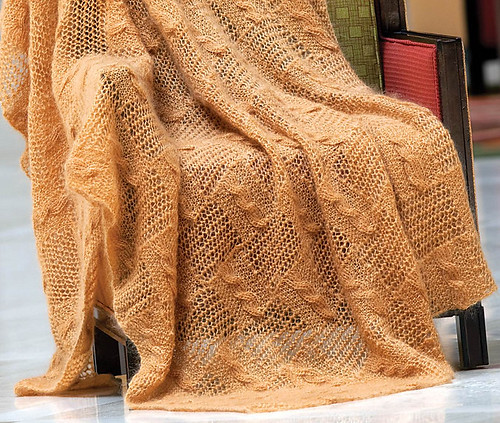
I’ve been meaning to design an entrelac lace shawl for years. It’s still in the early stages of the design, but every so often I mull it over and refine my initial idea. This is an afghan, but it shows how effective it can be to combine entrelac with other types of knitting.
Another combination that really is right up my alley is with doubleknitting. Entrelac usually has a very pronounced right side vs wrong side, but with doubleknitting you end up with two “right” sides.

Really, I think that by combining various techniques, you can create items that are truly unique and wonderful And Gwen definitely manages to convey the love of entrelac and the joy of exploring new challenges in the book. She gives enough information to learn the techniques, and then describes ways to broaden the horizons from there.
Gwen blogs on regularly at Two sides – Two points together with Kellie Nuss. They recently published a review of my Shaping Shawls. If you’d like to read it, it can be found here.


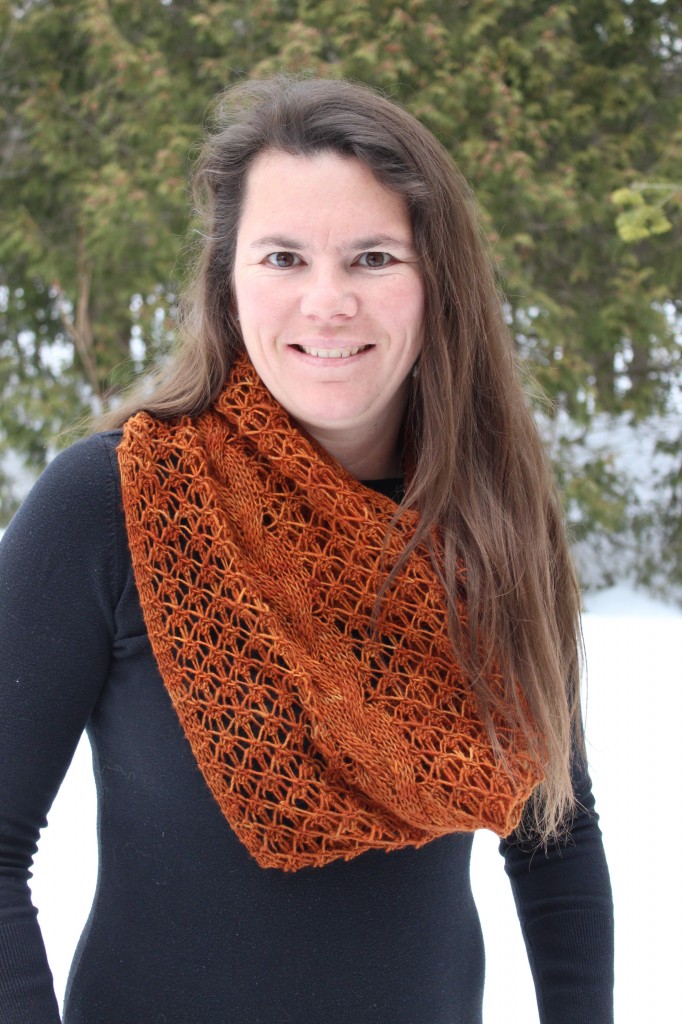
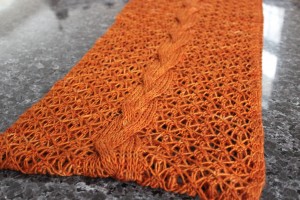


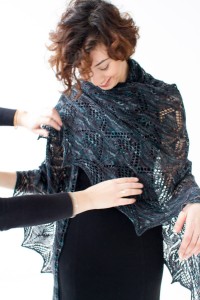
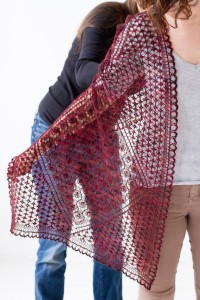
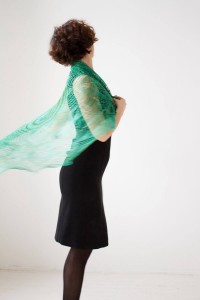

Recent Comments